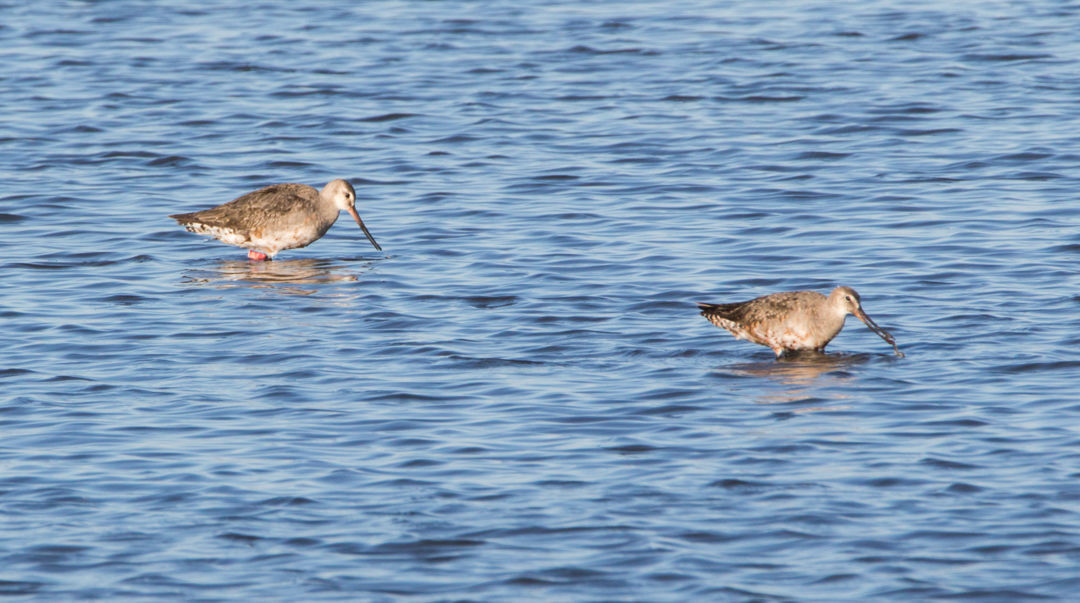
Hudsonian godwit. Photo: Jesse Kolar
Submitted by Corey Ellingson, Bismarck-Mandan Bird Club
BISMARCK, N.D. (NewsDakota.com) – One of the great things about birding is you never know what you may experience.
In May, I wrote of a chance encounter with an American badger that gave me a stare down for a good 10 minutes before I chose to leave the scene. Of course, I have been seen plenty of fawns sporting their spotty coats. I even saw a mother mule deer escorting a pair of fawns down a street in Watford City the other morning.
Recently I was birding with a friend in the southeast part of the state. We encountered a large wetland created by 10 inches of rain that soaked a several-county area the end of July. As I was scoping through the shorebirds taking advantage of the newfound habitat, I called out a pair of Hudsonian godwits, which is an uncommon species.
They are more prevalent in spring and handsome, sporting their brick red plumage and bold white eye-line on a dull gray head. In fall, most of the brick is gone, but this varies greatly among individuals. My friend swung over to observe and noticed one was banded.
Every year, we birders have the great fortune of observing a banded avian friend. The trouble is, can we observe that band close enough to read it? With the help of a large telephoto lens, and steady hands, sure enough diagnostic photos were obtained of this individual.
I have seen bands on waterfowl easily enough, but if the bands are on shorebirds their legs can be under water. Or worse yet, if it is a tiny little warbler, reading a band would be impossible. Some bird banding uses a color scheme rather than numbers. Using two color bands on both legs, this gives a researcher many combinations.
Upon posting a photo of the bird to North Dakota Birding on Facebook, someone quickly let us know that a red band on a Hudsonian godwit most likely comes from Chile! Now I knew shorebirds are a true marvel of migration in the avian world, but this migration feat is truly very hard to fathom.
I did a quick Google search and found this article if you care to read more in-depth: https://www.allaboutbirds.org/news/fantastic-journeys-shorebirds-are-next-level-athletes/. This article states about 20 species of shorebirds have been known to make nonstop flights of 5,000 kilometers (3,100 miles) or more! The distance champion is the bar-tailed godwit, which flies from nesting grounds in Alaska to winter on the coasts of New Zealand, which is 12,000 kilometers nonstop in nine days! I used to dread running a mile for gym class; I have idea how these birds do these flights twice a year.
Banded shorebirds with colored flags can be reported at bandedbirds.org. Federal bands (metal bands) can be reported on the following website https://www.pwrc.usgs.gov/BBL/bblretrv/. Upon reporting our bird band with photo, we were able to get a quick email response from the bander himself:
“Many thanks for sending this awesome re-sighting! a/R(JLJ) was a Hudsonian godwit banded along with 6 conspecifics by 9th December 2017. Individuals were banded at a bay close to Quellón village, Chiloé island, Chile more than [6,800 miles] away from the re-sighting area!”
So this feathered friend we were now observing has flown from Chile to Alaska and back at least three times already, and hopefully will continue this routine several more times in years to come.
We may casually enough notice a bird taking a breather in our backyard or taking a dip in our bird bath, or feeding up on tasty morsels in the treetops. Little do we know but they have a lot on their mind as they prepare for another arduous journey to the great beyond. Birds are quite amazing creatures.
